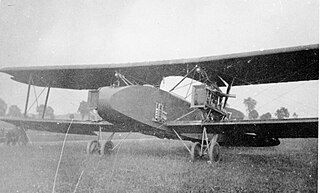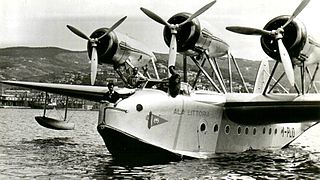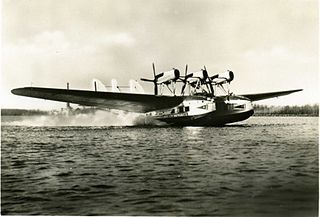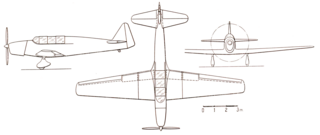Related Research Articles

The Albatros G.III, was a German bomber aircraft development of World War I. It was a large, single-bay biplane of unequal span and unstaggered wings. Power was provided by two Benz Bz.IVa pusher engines installed in nacelles carried between the wings. An unusual feature of the design was that the lower wing was provided with cutouts for the propellers, allowing the engine nacelles to be mounted further forward than would have been otherwise possible. Few were built, these seeing service mostly on the Macedonian Front in 1917.

The Maurice Farman MF.11 Shorthorn is a French aircraft developed before World War I by the Farman Aviation Works. It was used as a reconnaissance and light bomber during the early part of World War I, later being relegated to training duties.

The Caproni Ca.18 was a military reconnaissance aircraft built in Italy shortly prior to World War I. It became the first Italian-designed and -built aircraft to see service with the Italian armed forces. The Ca.18 was a monoplane of conventional configuration and fixed tailskid undercarriage. The wings were mounted to the fuselage with a bayonet fitting, to facilitate the rapid erection and dismantling of the aircraft.

The Macchi M.C.100 was an Italian commercial flying boat designed and built by Macchi.

The Fiat B.R. 1/4 was a light bomber series, developed in Italy shortly after World War I.

The Fiat R.2 was a reconnaissance aircraft produced in Italy shortly after World War I, and the first aircraft to be marketed under the Fiat brand,. It was a conventional two-bay biplane with equal-span, unstaggered wings and fixed tailskid undercarriage. The pilot and observer sat in tandem open cockpits. The design was a derivative of the SIA 7 and SIA 9 flown during the war, but was considerably revised by Rosatelli to correct ongoing problems with those types. A total of 129 were produced for the Air Corps of the Regio Esercito.

The Pomilio PE was a First World War Italian armed reconnaissance biplane designed and built by the Pomilio brothers. It was developed from the earlier Pomilio PC and PD.

The Savoia-Marchetti S.59 was a 1920s Italian reconnaissance/bomber flying boat designed and built by Savoia-Marchetti for the Regia Aeronautica.

The Savoia-Marchetti S.66 was a 1930s Italian twin-hull flying boat designed and built by Savoia-Marchetti as an enlarged development of the S.55.

The General Aviation PJ was a flying boat produced in the United States in the 1930s as a search-and-rescue aircraft for the Coast Guard.
The Grahame-White Type XI was an early aircraft built in the United Kingdom and marketed as being particularly well-suited to military applications. It was a two-bay biplane of pod-and-boom configuration with unstaggered wings of slightly unequal span. The pilot and an observer sat in tandem, open cockpits in a streamlined nacelle, with the engine mounted pusher-fashion behind them. Unusually for an aircraft of this period, the propeller was not driven directly by the engine, but rather, via a sprocket and chain system that geared it down in the ratio of 14/23. The undercarriage was of the fixed, tailskid type but was designed to be easily exchanged for pontoons. Construction throughout was fabric-covered wood, with the exception of a neat aluminium cowling for the engine and transmission. A sample was exhibited at the Olympia Aero Show in 1914.

The Lohner L was a reconnaissance flying boat produced in Austria-Hungary during World War I. It was a two-bay biplane of typical configuration for the flying boats of the day, with its pusher engine mounted on struts in the interplane gap. The pilot and observer sat side by side in an open cockpit, and both the upper and lower sets of wings featured sweepback.

The Italian Corpo Aeronautico Militare was formed as part of the Regio Esercito on 7 January 1915, incorporating the Aviators Flights Battalion (airplanes), the Specialists Battalion (airships) and the Ballonists Battalion. Prior to World War I, Italy had pioneered military aviation in the Italo-Turkish War during 1911–1912. Its army also contained one of the world's foremost theorists about the future of military aviation, Giulio Douhet; Douhet also had a practical side, as he was largely responsible for the development of Italy's Caproni bombers starting in 1913. Italy also had the advantage of a delayed entry into World War I, not starting the fight until 24 May 1915, but took no advantage of it so far as aviation was concerned.

The Macchi M.9 was a flying boat bomber designed by Alessandro Tonini and produced by Macchi in Italy close to the end of World War I and shortly afterwards.

The SIAI S.13 was an Italian biplane reconnaissance flying-boat from 1919.

The Rumpler G.I was a bomber aircraft produced in Germany during World War I, together with refined versions known as the G.II and G.III.

The SABCA S.40 was a military trainer aircraft built in Belgium in 1939.
The Savoia-Pomilio SP.2 was a reconnaissance and bomber aircraft built in Italy during the First World War. It was a refined version of the SP.1, and like it, took its basic configuration from the Farman MF.11: a biplane with twin tails and a fuselage nacelle that accommodated the crew and a pusher-mounted engine. The SP.2 entered mass production with SIA, and with co-designer Ottorino Pomilio's own firm that he had recently established.

The Savoia-Pomilio SP.3 was a reconnaissance and bomber aircraft built in Italy during the First World War.
The Savoia-Pomilio SP.4 was a reconnaissance and bomber aircraft built in Italy during the First World War. It was a further development of the family of designs that had started with the SP.1. Ultimately all of these took their basic configuration from the Farman MF.11: a biplane with twin tails and a fuselage nacelle that accommodated the crew and a pusher-mounted engine. However, the SP.4 differed both from its Farman antecedent and the previous Savoia-Pomilio designs by featuring twin engines mounted in the interplane gap in place of the single engine in the nacelle. Removing the engine from this position allowed a second machine gun to be placed there instead.
References
- The Illustrated Encyclopedia of Aircraft. London: Aerospace Publishing.
- "Savoja-Pomilio S.p.1". Aerei Italiani. Retrieved 2009-03-03.
- Taylor, Michael J. H. (1989). Jane's Encyclopedia of Aviation. London: Studio Editions.